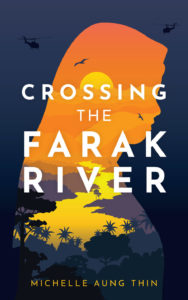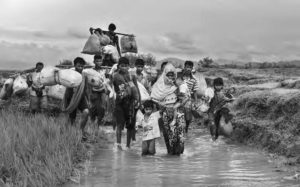 According to the United Nations, there are more than twenty-six million refugees in the world today, the highest number ever recorded. The geographic dispersion of this population shows that the phenomenon is truly a global one. Moreover, if recent trends are any indication, the proliferation of refugees caused by violent conflict will not reverse itself anytime soon. As such, it ever more imperative that we and our students have a better and more empathy-based understanding of the “backstory” of those who fall into this category.
According to the United Nations, there are more than twenty-six million refugees in the world today, the highest number ever recorded. The geographic dispersion of this population shows that the phenomenon is truly a global one. Moreover, if recent trends are any indication, the proliferation of refugees caused by violent conflict will not reverse itself anytime soon. As such, it ever more imperative that we and our students have a better and more empathy-based understanding of the “backstory” of those who fall into this category.

Michelle Aung Thin’s Crossing the Farak River provides a fictional but reality-based account of one of these backstories. The book is described as suitable for ages eleven to sixteen, and the reading level and content matter seem very appropriate for learners in that age range. It takes readers inside an ethnic conflict that has captured international headlines and confounded observers trying—often in vain—to make sense of its viciousness. The book’s main character is fourteen-year-old Hasina, a member of the Rohingya minority from Rakhine State in western Myanmar, a group that has been described as among the most persecuted in the world today. The Rohingyas’ vulnerability comes from not only their Muslim religious affiliation—Myanmar is a majority Buddhist country—but also from the Myanmar government’s assertion that many of them do not have valid claims to citizenship, alleging that they are in fact Bengalis from neighboring Bangladesh. Those ingredients for intolerance increasingly infuse Hasina’s environment, seeping through as disparaging comments made to and about her based on her Rohingya identity, or through worries expressed by the adults in her life.
The story’s setting is the “clearance operations” carried out by the Myanmar military in 2016–2017, which resulted in the burning of Rohingya villages and property, and the killing and violent abuse of many innocent people. These operations also propelled the exodus of hundreds of thousands of Rohingya, many of them landing in Bangladesh, where their plight has entered a new phase of heartbreak and misery. Hasina provides a ground-level view of those initial events and how forces beyond her control change life as she knows it beyond recognition, and what it means to show courage in the face of seemingly impossible odds.

The story opens with the distant sound of helicopters, which we soon learn are military aircraft. Their appearance delights Hasina’s six-year-old brother, Araf, but leaves Hasina feeling deeply unsettled. She is perceptive enough to recognize that they are a potentially ominous sign; years earlier, her cousin Ghadiya had come to live with Hasina’s family from another part of the country, and while Hasina does not know the details of Ghadiya’s experience, she recognizes that whatever it was that drove Ghadiya and her family from their home left psychological scars from which her cousin has not yet healed. As the story unfolds, Hasina and her family pick up more and more troubling signs that merely the fact of being Rohingya may mean they are no longer safe in their own home and community.
Things take a dramatic turn when Hasina’s village is attacked by the military, and survival instincts compel her and the rest of her family to flee for safety. But, as is sometimes the case in such circumstances, the family gets separated, with Hasina, Araf, and Ghadiya left to fend for themselves and not knowing her parents’ location or whether they are even safe. The three children hide in the forest, and as the days tick by, Hasina’s hope that her father will find them as promised begins to fade. When the trio emerges and makes their way back to their village, they discover the charred remains of the place they once called home.
In one particularly poignant scene, Hasina returns to the shop owned by her family to find that the goods they once sold lie on the floor, trampled and slashed to pieces. The “luxurious” Danish biscuits they once sold had been thrown from their containers and “stamped to powder.” “Who could have done such a thing?” she wonders. “Why not just steal? Why destroy like this so no one has the benefit of it? Why waste what is good?” Her words give expression to the sentiments of so many people in the real world who have tried to comprehend the gratuitousness and cruelty with which the Rohingya have been treated.
Hasina, Araf, and Ghadiya are traumatized and confused, but alive. They manage to locate Hasina’s grandmother and take into their fold others who find themselves alone and abandoned after the Myanmar military’s clearance operations. But of course, Hasina’s relief at having survived is only partial, as she searches desperately for any news about her parents. It is not until the story’s end that she discovers that her mother and father are safe. The author is not explicit about where the parents are but possibly implies that they reached Bangladesh, a country now hosting more than one million Rohingya, most of whom have claimed refugee status since the real-world events that are the backdrop to Crossing the Farak River.

The final twist in the story is the abduction and subsequent rescue of Araf by a non-Rohingya who is later implicated in child trafficking. The incident certainly adds drama to the story and reinforces Hasina’s role as a tireless protector. This aspect of the book can also be connected to the wider story —the special vulnerabilities that children are subjected to in such conflict situations. However, it feels like an unnecessary addition to the book, as the story already has ample dimensions worth exploring. Moreover, some of the names of ethnic groups and actors that are mentioned are central to the real-life story but may require that teachers give their students a bit of background or contextualization. At the end of the book is a historical timeline that will be of use for contextualization and a glossary of local language terms used throughout the story. The sheer number of languages used (six) should give students a sense of the very multiethnic nature of the country where this story takes place.
The book’s author thoughtfully introduces characters and actions that complicate our tendency to put all members of an ethnic group in either/or categories of “good” and “bad” or “perpetrator”
and “victim.” Readers learn at one point that the family of an abandoned child taken in by Hasina and her family was likely killed by a militant Rohingya group. There are non-Rohingya characters who, in showing acts of compassion and concern, demonstrate that human nature often defies binary classification. This is not something to which the author draws extensive attention, but is nonetheless worth pointing out to students in discussing the book: a reminder that one’s religious or ethnic identity is not always a determinative of individual moral intent or actions.
The book may be read on its own without supplemental materials to set the story in its real-life context. If teachers wish to connect the events described through Hasina’s experience with their own
and students’ life experiences and prior contextual knowledge, there is no shortage of useful resources available. For example, the organization Facing History and Ourselves, which specializes in materials and methods for teaching about the importance of learning from historical wrongs, has a resource titled “Understanding the Conditions that Lead to ‘Ethnic Cleansing,’” which focuses specifically on the Rohingya case.1 The resource suggests key terms that could be useful in equipping students for a class discussion or assignment. It also helpfully points to easily accessible media resources that provide background on the Rohingyas’ situation and detailed, step-by-step instructions on classroom activities that help bring to the surface the larger moral and international implications of what students are exposed to through Crossing the Farak River.
For teachers and/or higher-grade or more advanced students, the Council on Foreign Relations has an excellent “backgrounder” on the Rohingya crisis.2 This multimedia resource includes a kind of FAQ-style series of questions and explanations on the historical background, a map that helps orient students to the geography of the Rohingya crisis, and a slideshow that depicts visually what it is like to be on the now well-trodden refugee trail from Myanmar’s Rakhine State—where Hasina’s story takes place—to Bangladesh. Similarly, The New York Times put together a very compelling interactive slideshow with accompanying text that will help situate readers in a real-life case with real-life people. Although many of the images are suitable for teenage learners, some images and content may be disturbing, so teachers should review the material ahead of time to ensure appropriateness for their students.3
For teachers wanting a deeper understanding of an issue whose violence and viciousness is so confounding, Frances Wade’s Myanmar’s Enemy Within: Buddhist Violence and the Making of Muslim “Other” is highly recommended and readable. It is a careful examination of the elements that fueled the crisis, and highlights international agencies’ and organizations’ repeated failures to intervene. Insights presented in the book may not be directly applicable to classroom teaching, but certainly enhances teachers’ own understanding of the complexities of the issue that forms the backdrop to Crossing the Farak River.
This book is a valuable addition to the educational materials available on global migration and refugee flows, as it focuses on telling a fictional tale of a refugee’s backstory—that is, the life they had
before they became a UN statistic.
1. See Facing History & Ourselves, “Understanding the Conditions that Lead to ‘Ethnic Cleansing,’” available at https://tinyurl.com/5cth59jn.
2. Eleanor Albert and Lindsay Maizland, “The Rohingya Crisis,” Council on Foreign Relations, January 23, 2020, available at https://tinyurl.com/5n93fzfz.
3. Thomas Munita, Ben C. Solomon, Mona El-Naggar, and Adam Dean, The New York Times, December 21, 2017, available at https://tinyurl.com/4n5sjhv6.

